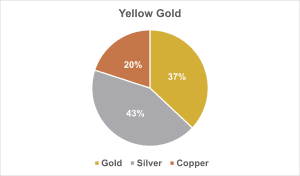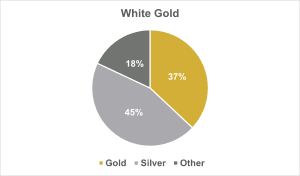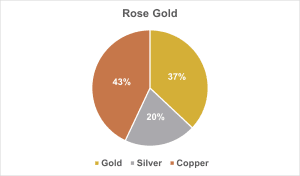The past few years have seen a phenomenal rise in the popularity of rose gold. It has evolved from being a somewhat outmoded color choice—more common in Italy and other European nations—to a timeless style for home interiors and accessories, and it doesn’t seem to be going away anytime soon.
Rose gold has become increasingly popular in recent years, capturing hearts with its warm, romantic, and elegant aesthetic. But beyond its captivating beauty, many wonder: is rose gold real gold? The answer is a resounding yes!
This guide delves into the fascinating world of rose gold, exploring its composition, history, and unique characteristics. We’ll answer all your burning questions, including:
- What exactly is rose gold?
- How does it differ from yellow and white gold?
- What are the benefits of choosing rose gold for your jewelry?
- How does the price of rose gold compare to other precious metals?
Whether you’re a seasoned jewelry enthusiast or just starting to explore the world of precious metals, this guide will provide you with all the information you need to make informed decisions about your next rose gold purchase.
Unveiling the Secrets of Rose Gold: A Blend of Beauty and Strength
Rose gold, also known as pink gold, derives its captivating hue from a unique blend of pure yellow gold and copper. The higher the copper content, the deeper the reddish-pink color of the rose gold. This versatility allows jewelers to create a spectrum of rose gold shades, from delicate blush tones to rich, vibrant hues.
While copper plays a crucial role in giving rose gold its distinctive color, it also enhances its durability. Pure gold, particularly 24 karat gold, is too soft for everyday wear and requires alloying with other metals for added strength. Rose gold, with its copper content, offers the perfect balance of beauty and resilience, making it an ideal choice for exquisite jewelry pieces that will stand the test of time.
Understanding Karat: The Measure of Gold Purity
The karat system is used to measure the purity of gold in an alloy. 24 karat gold represents pure gold, while lower karats indicate a mixture of gold and other metals. For instance, 18 karat gold contains 75% pure gold and 25% other metals, while 14 karat gold comprises 58.3% pure gold and 41.7% other metals.
Rose gold is typically available in 14 karat and 18 karat variations. 14 karat rose gold, with its higher copper content, boasts a more pronounced reddish-pink hue, while 18 karat rose gold offers a subtler rose tint with a hint of yellow gold The choice between these two options depends on personal preference and desired color intensity.
A Historical Journey: The Rise of Rose Gold
Rose gold’s origins can be traced back to 19th-century Russia, where the renowned jeweler Carl Fabergé first incorporated it into his exquisite Fabergé Eggs. This precious metal later found its way to the United States during the Art Deco era, where it adorned elaborate and feminine jewelry designs.
In the 1920s, Cartier, a renowned jewelry designer, played a pivotal role in popularizing rose gold. He incorporated this captivating metal into fine jewelry and engagement rings, showcasing its versatility and elegance. Cartier’s iconic “Trinity Ring,” featuring three intertwined bands of yellow, white, and rose gold, further cemented rose gold’s place in the world of luxury jewelry.
Throughout history, rose gold’s popularity has ebbed and flowed, influenced by fashion trends and celebrity endorsements However, in recent years, it has experienced a resurgence, captivating hearts with its timeless beauty and versatility.
Comparing Rose Gold to Other Precious Metals: A Tale of Unique Charm
Rose gold stands out from other precious metals like yellow and white gold due to its unique color and aesthetic appeal. While yellow gold exudes a classic and timeless elegance, white gold offers a modern and sophisticated look. Rose gold bridges the gap between these two styles, combining the warmth of yellow gold with the contemporary appeal of white gold.
Rose gold’s versatility allows it to complement various skin tones and styles, making it a universally flattering choice. It pairs beautifully with diamonds, gemstones, and other metals, offering endless possibilities for customization and personalization.
The Allure of Rose Gold: Reasons to Embrace this Precious Metal
There are numerous reasons why rose gold has become a favorite among jewelry enthusiasts:
-
Unique and Romantic Aesthetic: Rose gold’s warm, rosy hue evokes a sense of romance and femininity, making it an ideal choice for engagement rings, wedding bands, and other special occasion jewelry.
-
Complements Various Skin Tones: Rose gold’s versatility allows it to flatter a wide range of skin tones, from fair to olive to deep. Its warm undertones create a harmonious balance, enhancing the wearer’s natural beauty.
-
Pairs Beautifully with Diamonds and Gemstones: Rose gold’s warm tones provide a stunning backdrop for diamonds and gemstones, enhancing their brilliance and adding depth to their colors.
-
Durable and Long-Lasting: Rose gold’s copper content enhances its durability, making it resistant to scratches and wear, ensuring your jewelry remains beautiful for years to come.
-
Timeless and Versatile: Rose gold’s classic appeal transcends fleeting trends, making it a timeless choice that will never go out of style. Its versatility allows it to seamlessly transition from casual to formal occasions.
Demystifying the Price of Rose Gold: A Comparison with Other Precious Metals
The price of rose gold can vary depending on factors such as karat, design complexity, and the presence of gemstones. However, in general, rose gold tends to be slightly more expensive than yellow gold due to the higher copper content and the specialized craftsmanship required to achieve its unique hue.
When compared to white gold, rose gold is often more affordable. White gold requires rhodium plating to maintain its bright white color, which adds to its overall cost. Rose gold, on the other hand, does not require plating, making it a more budget-friendly option.
Choosing Rose Gold: A Decision for Timeless Elegance and Versatility
Whether you’re seeking a romantic engagement ring, a statement necklace, or a pair of elegant earrings, rose gold offers a unique and versatile choice that will elevate your jewelry collection. Its warm, rosy hue, durability, and timeless appeal make it an investment you’ll cherish for years to come.
If you’re considering rose gold for your next jewelry purchase, here are some factors to consider:
-
Karat: 14 karat rose gold offers a more pronounced reddish-pink hue, while 18 karat rose gold provides a subtler rose tint with a hint of yellow gold. Choose the karat that best aligns with your desired color intensity.
-
Design: Rose gold’s versatility allows it to complement various designs, from vintage-inspired to modern and contemporary. Consider the overall style you’re aiming for and choose a design that reflects your personal taste.
-
Gemstones: Rose gold pairs beautifully with diamonds, gemstones, and other metals. Explore different combinations to create a unique and personalized piece that reflects your style.
-
Budget: Rose gold is generally more expensive than yellow gold but more affordable than white gold. Determine your budget and choose a piece that fits comfortably within your financial constraints.
Rose gold’s captivating beauty, versatility, and timeless appeal have made it a beloved choice among jewelry enthusiasts. Whether you’re drawn to its romantic hue, its durability, or its ability to complement various styles, rose gold offers a unique and elegant option that will elevate your jewelry collection. Embrace the enchantment of rose gold and discover the endless possibilities it holds for your personal style.
Is rose gold real gold?
Yes, rose gold is real gold. It’s still considered gold even though it’s made of a mixture of pure gold and other alloys.
Rose gold vs yellow gold vs white gold
What makes rose gold different from white and yellow gold? The exact mix of components that goes into making a gold alloy affects not just its color but also its carat value.
Different bullion producers have different recipes, and the majority are very closely kept secrets. However, generally speaking, 9ct alloys can be roughly divided into the following base ingredients when comparing rose gold vs. white and yellow gold:



Is Rose gold REAL GOLD?!
FAQ
Is rose gold a good quality gold?
Is rose gold same value as gold?
Is rose gold 100% gold?
Is rose gold considered cheap?
What is rose gold?
Rose gold is an alloy created by mixing pure gold with copper, resulting in a pinkish hue. The history of rose gold can be traced back to 19th century Russia, where it was often referred to as Russian gold. In Russia, the brilliant jeweler Carl Fabergé was one of the early pioneers to adopt and popularize rose gold in his intricate designs.
Is rose gold pure gold?
The inclusion of copper gives it the distinctive rosy color, while the percentage of gold within the alloy determines its karat value. The higher the gold content, the more valuable the rose gold piece. Thus, while rose gold is not pure gold, it is indeed composed of real gold and retains its value based on its gold content.
Why is rose gold not 100% gold?
In the case of rose gold, it’s alloyed with both copper and silver. The metals added to the pure gold serve a few purposes. In the case of rose gold, the copper and the silver add the pink color that’s desired from a metal called rose gold. But there’s another reason most gold jewelry isn’t 100% gold. Gold by itself is a soft metal.
What is rose gold jewelry?
Rose gold is an increasingly popular metal choice for jewelry due to its unique color and versatile properties. It is not pure gold, but rather an alloy, which is a mixture of metals. In the case of rose gold, it is created by combining gold with copper and sometimes silver, giving it a distinct pinkish hue.
